A special education case came through the transom last week, courtesy of a group of parents in Millburn, New Jersey. The case pinpoints a few percolating problems in NJ’s special education arena, particularly school districts’ struggles to provide adequate services to kids with a diagnosis of autism. This case, J.S. and K.S. v. Millburn Township Board of Education (not yet online, but I’ve posted it here for reference) touches on some districts’ reluctance to classify kids as autistic, the politics of district/parent negotiations, and the role of our consortium of private education schools.
This December 7th ruling involves a young girl, referred to in court documents as A.C., and the services offered to her by Millburn Public Schools, an Essex County district that is rated as a “J” District Factor Group, the wealthiest possible designation. In October 2008, the child’s parents approached the district because of concerns with her speech and social development. A.C. had just turned three years old and, under federal and state law, was eligible for special education services through her local school district.
To any informed lay reader, A.C. displayed clear signs of autistic-like symptoms. Most of her speech was unintelligible. She made little or no eye contact, rocked back and forth, exhibited repetitive behavior, showed no evidence of imaginary play, had no interest in peers, and recited scripts from “Dora the Explorer” episodes.
Monthly Archives: January 2013
UW a great value in public education, survey says
If Wisconsin students and parents are looking for one of the best values in the country in higher education, stay at home.
Kiplinger’s Personal Finance has ranked UW-Madison 13th in its list of the 100 best values in public colleges, the second year in a row the state’s flagship university has been ranked in that spot.
The survey tapped North Carolina as the best value in public education for the 12th year in a row, or since the survey started.
The publication looked at data from close to 600 public four-year colleges and universities to come up with the survey results, based on criteria such as admission rates, percentage of student returning to school as sophomores, student-faculty ratios, tuition, financial aid and low average debt at graduation.
50 Things
As you begin your college experience, and I prepare for my 10-year college reunion, I thought I’d leave you with the things that, in retrospect, I think are important as you navigate the next four years. I hope that some of them are helpful.
Here goes…
Your friends will change a lot over the next four years. Let them.
Call someone you love back home a few times a week, even if just for a few minutes.
In college more than ever before, songs will attach themselves to memories. Every month or two, make a mix cd, mp3 folder, whatever – just make sure you keep copies of these songs. Ten years out, they’ll be as effective as a journal in taking you back to your favorite moments.
Statistics vs. Machine Learning, fight!
10/1/09 update — well, it’s been nearly a year, and I should say not everything in this rant is totally true, and I certainly believe much less of it now. Current take: Statistics, not machine learning, is the real deal, but unfortunately suffers from bad marketing. On the other hand, to the extent that bad marketing includes misguided undergraduate curriculums, there’s plenty of room to improve for everyone.
So it’s pretty clear by now that statistics and machine learning aren’t very different fields. I was recently pointed to a very amusing comparison by the excellent statistician — and machine learning expert — Robert Tibshiriani. Reproduced here:
Madison schools starting to embrace ‘restorative justice’ for problem behavior
The Madison School District is betting that restorative justice practices — giving people in conflict the opportunity to hear each other’s side of the story in an attempt to heal a rift — are a powerful tool in making schools safer, more productive places.
Following a two-year pilot project at La Follette High School and Black Hawk and Sennett middle schools, the district has entered into an agreement with the YWCA Madison to extend the program to East High School as well as Sherman, O’Keeffe, and Whitehorse middle schools.
The school district has allocated $164,420 for payment to YWCA, which trains staff and helps run restorative practice circles, and made restorative practices part of its plan to close the achievement gap between students of color and white students.
To hear the students at Sennett Middle School tell it, restorative practices hold a lot of potential for helping students do better in school and for building more positive relationships.
Understanding School Discipline in California: Perceptions and Practice
This report on a new EdSource survey of 315 school districts–representing two-thirds of public school students in California–sheds new light on how the state implements student discipline policies.
Do online courses spell the end for the traditional university?
Two years ago, I sat in the back seat of a Toyota Prius in a rooftop car park in California and gripped the door handle as the car roared away from the kerb, headed straight towards the roof’s edge and then at the last second sped around a corner without slowing down. There was no one in the driver’s seat.
It was the prototype of Google’s self-driving car and it felt a bit like being Buck Rogers and catapulted into another century. Later, I listened to Sebastian Thrun, a German-born professor of artificial intelligence at Stanford University, explain how he’d built it, how it had already clocked up 200,000 miles driving around California, and how one day he believed it would mean that there would be no traffic accidents.
A few months later, the New York Times revealed that Thrun was the head of Google’s top-secret experimental laboratory Google X, and was developing, among other things, Google Glasses – augmented reality spectacles. And then, a few months after that, I came across Thrun again.
5 Most Inspirational Videos of 2012
These five short videos will remind you what’s important in life and work.
This has been a difficult few days for everybody, especially for those of us who have children in primary school.
I had already selected the following five clips as the most inspirational and motivational videos of the year.
I think they are testament to the fact that the human spirit is greater than tragedy and to remind us that the reason we all work so hard is because we want to make a difference in the world.
The Schoolmaster
David Coleman is an idealistic, poetry-loving, controversy-stoking Rhodes Scholar and a former McKinsey consultant who has determined, more than almost anyone else, what kids learn in American schools. His national curriculum standards and pending overhaul of the SAT have reignited a thorny national debate over how much we should expect from students and schools, and how much is out of their control.
On a hot June morning in suburban Delaware, in the chintzy, windowless ballroom of a hotel casino, David Coleman stood at a podium reciting poetry. After reading Dylan Thomas’s “Do Not Go Gentle Into That Good Night,” a classic example of the villanelle form, Coleman wanted to know why green is the only color mentioned in the poem, why Thomas uses the grammatically incorrect go gentle instead of go gently, and how the poet’s expression of grief is different from Elizabeth Bishop’s in her own villanelle, “One Art.”
“Kids don’t wonder about these things,” Coleman told his audience, a collection of 300 public-school English teachers and administrators. “It is you as teachers who have this obligation” to ask students “to read like a detective and write like an investigative reporter.”
Why Kids Should Grade Teachers
Nubia Baptiste had spent some 665 days at her Washington, D.C., public school by the time she walked into second period on March 27, 2012. She was an authority on McKinley Technology High School. She knew which security guards to befriend and where to hide out to skip class (try the bleachers). She knew which teachers stayed late to write college recommendation letters for students; she knew which ones patrolled the halls like guards in a prison yard, barking at kids to disperse.
If someone had asked, she could have revealed things about her school that no adult could have known. Once Nubia got talking, she had plenty to say. But until that morning of her senior spring, no one had ever asked.
She sat down at her desk and pulled her long, neat dreadlocks behind her shoulders. Then her teacher passed out a form. Must be another standardized test, Nubia figured, to be finished and forgotten. She picked up her pencil. By senior year, it was a reflex. The only sound was the hum of the air conditioning.
“I Was Adam Lanza”
The Daily Beast
Recently, the Huffington Post published an article titled “I am Adam Lanza’s mother” by a woman named Liza Long. The article presents a picture of a 13-year-old boy who threatened his mother, sometimes going so far as to pull a knife on her, scream obscenities at her, and leap out of cars as they’re driving down the highway.
The rest of the world has reacted to the idea of such a child with horror and incomprehension. I sympathize with the horror. I can only wish that I shared the incomprehension. I understand, intimately, how Liza Long’s son feels. I was like him.
Like the author of that piece, Liza Long, my mother had no idea what to do about my sudden transformation (in my case, around 16) into a borderline homicidal maniac. Like her son, I used knives to try and make my threats of violence seem more real. Like her son, I would leap out of our car in the middle of the road just to get away from my mother, over the most trivial of offenses. Like her son, I screamed obscenities at my mother shortly after moments of relative peace. And worse than this poor woman’s son, whose mindset toward his peers we can only guess, I will admit that I fantasized multiple times about taking ordnance to my classmates.
By the logic which leads Liza Long to say, “I am Adam Lanza’s mother,” I have to say: “I was Adam Lanza.”
This is a very honest, generous, and thought-provoking piece … and one from an important source.
Milwaukee Public Schools needs a new backbone & A Few Useful Madison Data Points
The Public Policy Forum recently published a new report (4MB PDF Link) that, like many previous reports from a variety of think tanks, casts doubt on the fiscal future of Milwaukee Public Schools. However, the PPF report added an interesting twist by throwing down a challenge to state and local political leadership.
It is time “to define where MPS fits into Milwaukee’s education framework,” they concluded, and to “define and secure the resources needed to effectively fulfill that role.”
In other words, quit complaining about MPS and do something. The district, beset with long-term budget woes, is rapidly losing students whose parents want safer, better schools.
Generations of School Boards, superintendents and sympathizers have decried the inadequacy of state school aids. True or not, the more important question is: Will there be more money? While state aid will likely increase, it’s unlikely to match the expectations of some people, including Mayor Tom Barrett. The price tag to fix the state aid “funding flaw” as the mayor advocates is $50 million. Even on his best day, I doubt the mayor could convince the Legislature to write a check for that kind of money.
View the complete Public Policy Forum report on the Milwaukee Public Schools, here (4MB PDF).
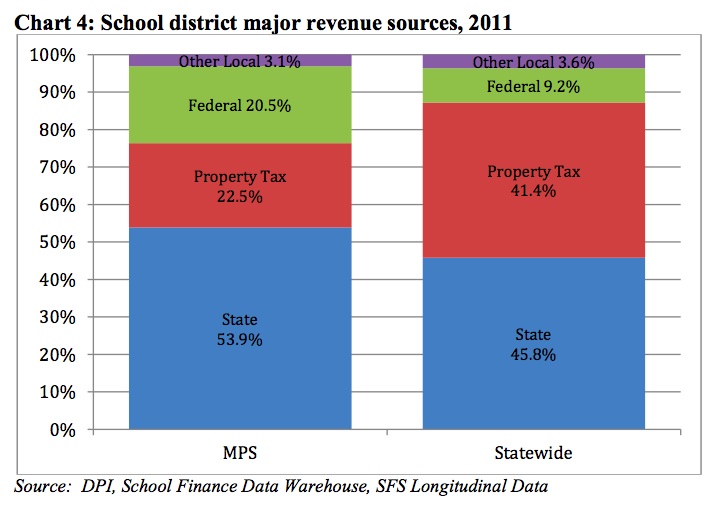
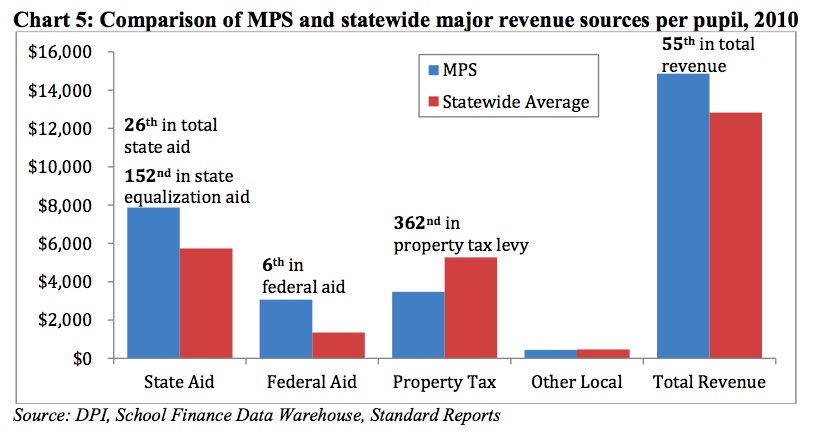
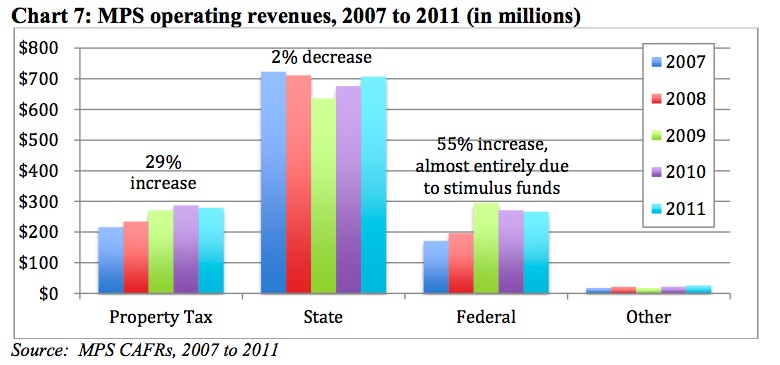
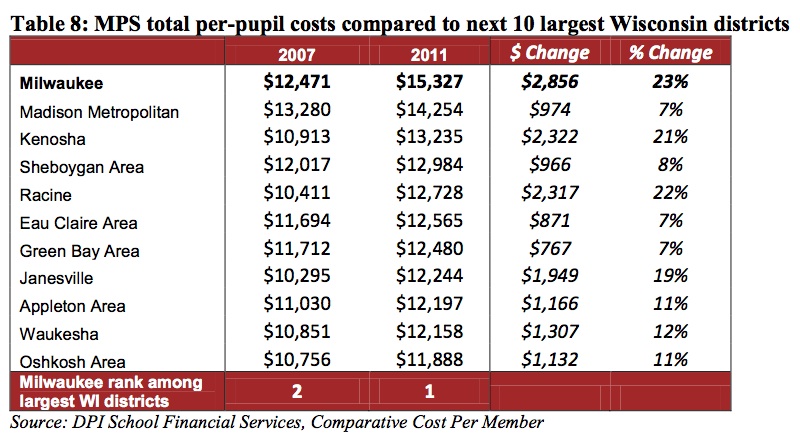
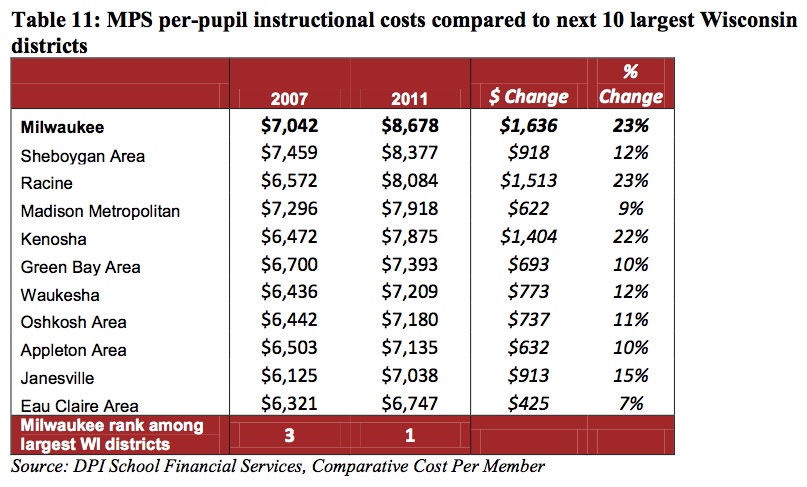
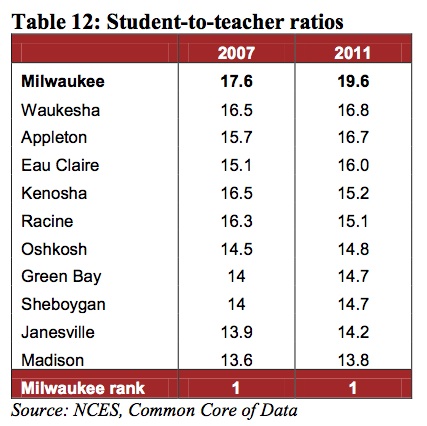
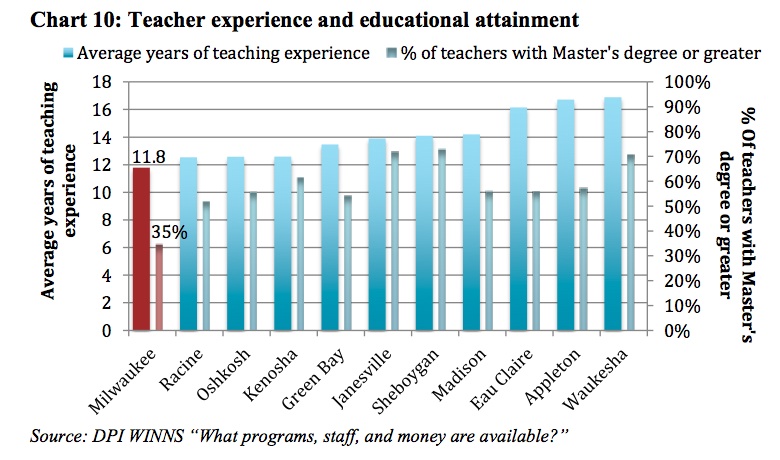
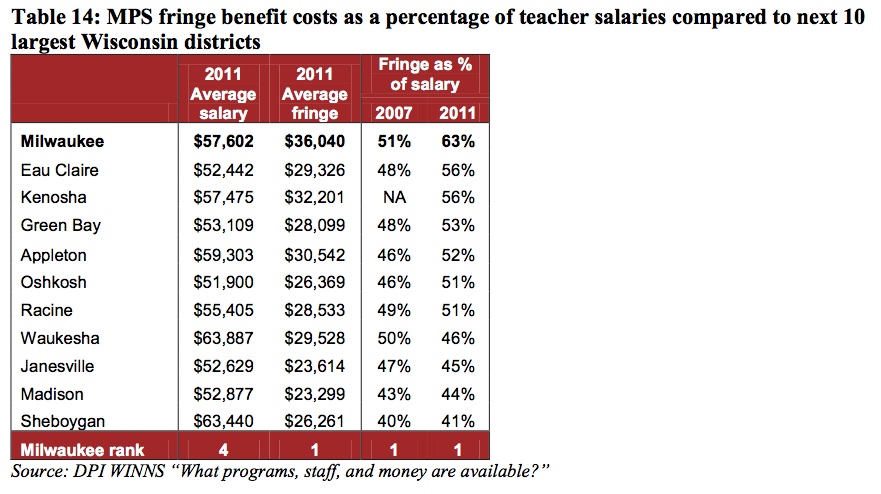
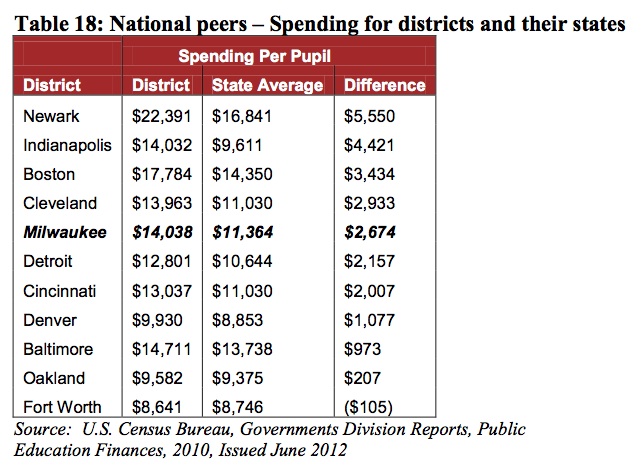
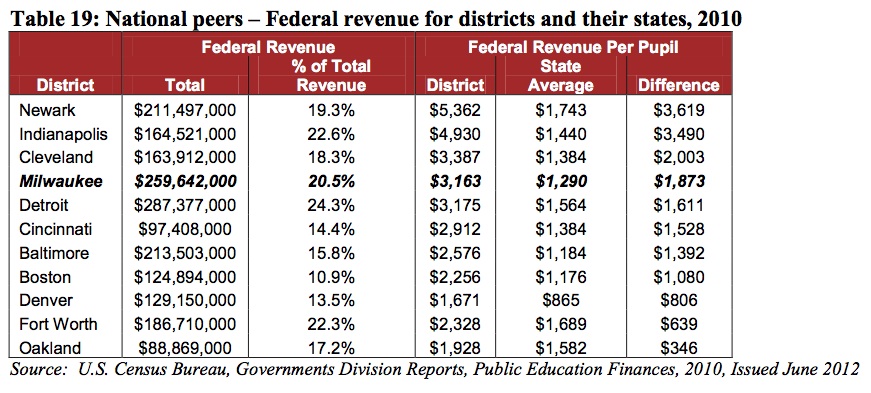
It would be interesting to see a peer comparison (State, National & Global) of Madison, as well.
The maths of exam marks
At the moment, the Department for Education is considering changes to the league tables and the exam system. This seems an opportune moment to make a simple point about qualification-awarding and accountability: English school examinations are subject to measurement error in a really big way.
Here is a simple thought experiment to flesh it out. Imagine a class of 100 students. Let us specify that each one has a “true” ability that means that one pupil should get one point, one pupil should get two, one should get three and so on – up to 100 marks. Now, let’s award this class one of 10 grades: 90+ gets you an A, 80+ a B and so on.
Let us assume that the tests are perfect. If that were the case, you would get ten individuals in each grade. Easy enough. But what happens if we start introducing errors into the test? We can do that with a set of exotically named (but very simple) “Monte Carlo” estimates, which I calculated using this simple spreadsheet.
2013 Wisconsin DPI Superintendent and Madison School Board Candidates
Patrick Marley & Erin Richards:
“I’ve been frustrated with the fact that our educational system continues to go downhill even with all the money the Legislature puts into it,” he said.
Pridemore said he will release more details about his educational agenda in forthcoming policy statements and has several education bills in the drafting phase. Asked if he believed schools should have armed teachers, he said that was a matter that should be left entirely to local school boards to decide.
Evers, who has been school superintendent since 2009, is seeking a second term. He has previously served as a teacher, principal, local school superintendent and deputy state schools superintendent.
Wisconsin’s education landscape has undergone some major changes during his tenure, including significant reductions in school spending and limits on collective bargaining for public workers that weakened teachers unions, which have supported Evers in the past.
Evers wants to redesign the funding formula that determines aid for each of Wisconsin’s 424 school districts and to provide more aid to schools. Also, he wants to reinvigorate technical education and to require all high schools to administer a new suite of tests that would offer a better way to track students’ academic progress and preparation for the ACT college admissions exam.
Don Pridemore links: SIS, Clusty, Blekko, Google and link farming. Incumbent Tony Evers: SIS, Clusty, Blekko, Google and link farming.
Matthew DeFour:
School Board president James Howard, the lone incumbent seeking re-election, faces a challenge from Greg Packnett, a legislative aide active with the local Democratic Party. The seats are officially nonpartisan.
Two candidates, low-income housing provider Dean Loumos and recently retired Madison police lieutenant Wayne Strong, are vying for Moss’ seat.
The race for Cole’s seat will include a primary on Feb. 19, the first one for a Madison School Board seat in six years. The candidates are Sarah Manski, a Green Party political activist who runs a website that encourages buying local; Ananda Mirilli, social justice coordinator for the YWCA who has a student at Nuestro Mundo Community School; and T.J. Mertz, an Edgewood College history instructor and local education blogger whose children attend West High and Randall Elementary schools.
K-12 Tax & Spending Climate: Don’t allow phony retirements
The findings of a recent state audit should remind state leaders — and their constituents — that the Legislature still needs to fix the “double dip.”
Taxpayers deserve tighter rules to guard against abuse, something the audit confirmed.
Double dipping allows public workers to “retire” and then return to their jobs just 30 days later to collect full-time salaries and pension income at the same time.
In the worst cases, some public employees — often top managers — have returned and stayed in their six-figure, full-time jobs for years after supposedly “retiring.” That costs more money, both in longer guaranteed pension payments and higher salaries than what younger, new hires in those positions would likely earn.
The Best Speech About Education — Ever
Every now and then a speech comes along that reminds me why public speaking is still essential and why I said back in 2003 that the only reason to give a speech is to change the world.
Today, Mike Johnston is a state senator from Colorado, but his passion is education, and it was ignited as a Teach for America teacher in the Mississippi delta in 1997. From that came a searing book, In the Deep Heart’s Core, about the terrible challenges facing teachers and learning in that state. Johnston moved on to become the principal of a school for challenged kids in Colorado.
Our creative director waxes lyrical about The Orchestra
A delight to behold – a feast for the eyes, the ears, and the heart.
The Orchestra is quite simply the most beautiful thing my company has ever made. Beautiful in every sense of the word. It’s filled with beautiful music. It’s filled with beautiful images. And it communicates its subject more beautifully than anything I’ve ever seen before.
Anything? Yes, anything.
Sure, there may be more beautiful paintings, more beautiful poems, or more beautiful sunsets. But I’m talking about things whose purpose is to communicate a sizable body of knowledge, to teach me something interesting about the world, to expand my horizons and deepen my understanding. I cannot think of anything, anywhere, in any medium, ever, that has done this as beautifully as the interactive experience we call The Orchestra.
Jerry Brown pushes new funding system for California schools
Gov. Jerry Brown is pushing hard to overhaul California’s convoluted school funding system. His plan has two major objectives: Give K-12 districts greater control over how they spend money, and send more dollars to impoverished students and English learners.
Studies show that such children require more public help to reach the same level of achievement as their well-off peers. But as rich and poor communities alike clamor for money in the wake of funding cuts, Brown’s plan could leave wealthy suburbs with fewer new dollars than poorer urban and rural districts.
That makes perfect sense, said Michael W. Kirst, president of the State Board of Education and a Stanford University professor who co-wrote a 2008 paper that became the model for Brown’s proposal.
“Low-income people have less resources to invest in their children,” Kirst said. “A lot of investment comes from parental ability to buy external things for their kids that provide a better education. In the case of low-income groups, they can’t buy tutors, after-school programs or summer experiences.”
Worst College Majors for Your Career
Make no mistake: An undergraduate degree can improve your employment prospects and paycheck size. A high school graduate earns 40% less than someone with a bachelor’s degree and is more than twice as likely to be unemployed. But not all college majors are created equal. In fact, grads with certain majors sometimes fare worse in the labor force than workers who stopped studying after high school.
Considering the time and expense that goes into earning a college degree, knowing whether your course of study is a career-killer is powerful knowledge indeed. That’s why we analyzed the jobless rates and salaries for graduates with the 100 most popular majors to come up with our list of the ten worst values in college majors.
Special Team: Chy Johnson & Her Boys
How about a little good news?
In the scrub-brush desert town of Queen Creek, Ariz., high school bullies were throwing trash at sophomore Chy Johnson. Calling her “stupid.” Pushing her in the halls.
Chy’s brain works at only a third-grade level because of a genetic birth defect, but she knew enough to feel hate.
“She’d come home every night at the start of the school year crying and upset,” says her mom, Liz Johnson. “That permanent smile she had, that gleam in her eye, that was all gone.”
Her mom says she tried to talk to teachers and administrators and got nowhere. So she tried a whole new path — the starting quarterback of the undefeated football team. After all, senior Carson Jones had once escorted Chy to the Special Olympics.
“Just keep your ear to the ground,” Liz wrote to Carson on his Facebook page. “Maybe get me some names?”
But Carson Jones did something better than that. Instead of ratting other kids out, he decided to take one in — Chy.
Study: Education Extends Longevity–Except for Black Males
The human longevity bonanza that gives newborns today three decades more of life expectancy than they would have had a century ago appears to have no real stopping point.
Now researchers are trying to determine how U.S. society should change to accommodate so many longer, healthier lifespans, and why one group of white Americans does not seem to be benefiting from the trend.
Published in the August issue of Health Affairs and reported widely in the media, the researchers’ study found that while everybody else is living longer, non-Hispanic white women without high school diplomas have actually lost five years of life expectancy and their male counterparts lost three years.
Why Education Emancipation is the Moral Imperative of our Time
These are–to be sure–radical claims, but they are true, and the abolition of public schools is an idea whose time has come. It is time for Americans to reexamine–radically and comprehensively–the nature and purpose of their disastrously failing public school system, and to launch a new abolitionist movement, a movement to liberate tens of millions of children and their parents from this form of bondage.1
Twenty-first century Abolitionists are confronted, however, by a paradoxical fact: Most Americans recognize that something is deeply wrong with the country’s elementary and secondary schools, yet they support them like no other institution. Mention the possibility of abolishing the public schools, and most people look at you as though you are crazy. And, of course, no politician would ever dare cut spending to our schools and to the “kids.”
For those who take seriously the idea that our public schools are broken and need to be fixed, the most common solutions include spending more money, raising standards, reducing class size, issuing vouchers, and establishing charter schools. And yet, despite decades of such reforms, our schools only get worse.
National Education Reform: School Choice Equals Opportunities For Hispanics
The Latino population is one of many groups affected by a national education reform. One of the most discussed programs is that of school choice, which varies from state to state, and offers families the opportunity to choose a school for their children other than the one assigned by geographic default.
Take for instance in Indiana, where a private-school choice program has more than 9,300 students involved.
“There’s a fairly extensive sort of tiered school choice/voucher program in its second year where based on income, kids could qualify for partial or full dollar amounts of what the state would spend on them in their district,” Indiana Commission on Hispanic and Latino Affairs Executive Director Daniel Lopez tells VOXXI. “It could be applied either partially or fully to a private school of their choice.”
Lopez said the program can be compared to a similar initiative in Florida, the only difference being the Hoosier State impacts more students. He added that enrollment is growing, which is a result of advocates spreading the world out in the Latino
5 Things to Know Before Taking Out a Student Loan
Wednesday’s Wall Street Journal reports that the federal lending program designed to make college education available to everyone is creating a pile of debt so large it is fanning worries that it has become too easy to borrow too much.
Looking to take out a student loan? Here are five things to know.
1. Research what aid is available to you–including scholarships, state and federal grants, and then federal loans. Meet with your school’s financial-aid counselor to learn these options. Visit the government’s website. The private website www.Finaid.org also has good resources.
2. Know the terms of your loans. What is the interest rate, what is the repayment period, and when precisely will payments begin? More importantly, find out what your expected monthly payment will be upon graduation. The financial aid counselor should be able to provide this. Also, learn about the federal government’s income-based repayment program.
Out Of Bounds: High Schools Should Ban Football
During a meeting of the Dover, N.H. school board in October, board member Paul Butler proposed a ban on high school football. The idea received stiff opposition. He told the board he believes they have “a moral imperative” to start ending the game in light of concussion research.
A tutorial from the business school of life
We cover many subjects in this section: new working patterns, women in management, immigrant start-ups, the future of computing, empowering staff, business’s responsibility to society. It is a wide spread and it is unusual to find it all in just one person.
But all these themes run through the life of Dame Stephanie Shirley – child refugee, software pioneer and crusading philanthropist – who, at the age of 79, has published her autobiography.
It is called Let IT Go, the capitalised middle word a play on “it” and “information technology”, which is a slightly limp introduction to the book’s bracing start.
Dame Stephanie was among the last of the 10,000 German, Austrian, Polish and Czech children allowed into the UK, without their parents, as the second world war loomed. Aged five, she and her older sister tumbled on to the platform at London’s Liverpool Street station, flotsam in a “river of exhausted, bewildered, tear-stained faces”.
Long Time Madison School District Citizen Activist Hospitalized After Stroke
Via Matthew DeFour. My prayers are with Don and his family. Madison and all schools could certainly use more citizen activists. Don Severson SIS notes and links.
College Football’s Big-Money, Big-Risk Business Model
Rachel Bachman & Matthew Futterman:
On one side are the nation’s largest universities, which face sharp declines in public funding. On the other, the cable and broadcast television networks, which are struggling to hold on to viewers and advertisers.
Like dynastic rulers desperate to protect their holdings, the two sides have engineered an alliance. The schools have offered up their most marketable asset, college football. The networks have agreed to marry the sport to the most important segment of their audience: the millions of viewers across the country who can still be counted on to drop whatever they are doing to watch live sports.
As a dowry, TV has agreed to pump about $25.5 billion in rights fees into college conferences and their member schools over the next 15 years. That includes a recent deal for ESPN to televise major-college football’s first playoff–a four-team bracket launching in 2014–that is valued at $5.6 billion over 12 years. The schools, meanwhile, are doing whatever is needed to maximize what they can command from TV: playing more games, jumping to new conferences, abandoning long-standing rivalries, dismantling the old system of postseason bowl games and, last June, approving that first-ever playoff.
How to make computer science courses better
As I sit here working on a project in lieu of going to class for the umpteenth time, I realized with sudden clarity that perhaps the current way that Computer Science is taught in universities is not the optimal way. Large lecture halls, clunky languages- it’s a bad sign when even a die-hard “learning for learning’s sake” student skips class on a regular basis.
anyway, a few thoughts on how I would change the structure of Computer Science courses to maximize efficiency + interest and minimize pain:
STOP TEACHING JAVA.
Seriously. I have never, ever been required to interview in a specific language at any company (even the “big names”), and if the people you’re talking to are deadset on Java, you probably don’t want to work there anyway. C is a much, much better “lower” level language for really grasping the way programming works, and Python is a much, much more fun language if you want to lower the barriers to entry and get students making things right away.
New Apps Show The Music Education Revolution Is Just Getting Started
Music will never be the same. But you knew that. You see it everyday when you share a playlist from Spotify or Songza, comment on a SoundCloud waveform or discover an artist who, as it turns out, got their start not in some Brooklyn dive bar, but on YouTube. Both the creation and distribution of music have been radically altered by technology.
So too has the way people learn how to play it.
This revolution is still young. As neat as some of this stuff is, innovation in music education is just beginning to heat up, and a handful of recent apps point to a future where learning music is easier, more accessible and even fun.
That technology is changing music education isn’t exactly breaking news. Music lessons come installed with GarageBand on every new Mac and app stores are overflowing with portable software that teaches music theory and guitar chords. Earlier this year, the New York Times ran a feature detailing how music teachers are using Skype and other digital communication tools to interface with students regardless of their physical location, a phenomenon that opens up new possibilities for teachers and learners alike. Meanwhile, sites like Coursera and Berklee Music offer comprehensive university-level classes in everything from songwriting to record production.
Is big disruption good for urban school districts?
My colleague Emma Brown has been looking closely at Chancellor Kaya Henderson’s plans to close one of every six traditional D.C. public schools.
In one piece, she cited activists who raised the possibility that the education system of our nation’s capital might, as a consequence of the downsizing, be split in two: Charter schools would rule the low-income neighborhoods, while regular public schools would thrive only in the affluent areas where achievement rates remain high.
This is not some wild nightmare. Education finance lawyer Mary Levy, a careful and longtime analyst of D.C. schools, said at one meeting: “What we are rapidly approaching is a [public school system] concentrated west of Rock Creek Park and perhaps around Capitol Hill, and a separate charter school system filled by lottery in most of the rest of the city.”
This is upsetting to many D.C. residents and people in the region who work or have lived in the city. But to some reformers, it is a great opportunity, a way to let parent choice energize the schools and give urban children more chances for success.
Football BCS Rankings, if Academics Mattered
The college football Bowl Championship Series rankings have been announced, but what would the list look like ranked instead by the teams’ academic achievement? The New America Foundation’s Education Policy Program today released its sixth annual BCS Academic Bowl rankings aiming to show just that.
The rankings use information collected by the NCAA — federal graduation rates and academic progress — to track educational success, not in-game performance. New America’s BCS Academic Bowl looks at data from the top 25 teams in the Bowl Championship Series’ final standings to rank their academic prowess.
New America’s analysis found:
Amsterdam schools to bring in ‘no toking zones’
Eberhard van der Laan’s introduction of a law that in other countries either already exists or seems so obvious it wouldn’t even require a rule is the result of the Netherlands’ unique drugs policy. Under the “tolerance” principle, marijuana is technically illegal here, but police can’t prosecute people for possession of small amounts.
That’s the loophole that made possible Amsterdam’s famed “coffee shops” – cafes where marijuana is sold openly. But it has also had the unwanted side effect that Dutch children are frequently exposed to the drug in public areas.
City spokeswoman Iris Reshef says schools have always forbidden pot, but found it difficult to enforce the policy when students smoked on or near campus and challenged administrators to do anything about it.
“It’s not really what you have in mind as an educator, that children would be turning up for class stoned, or drunk either for that matter,” she said. “But it has been a problem for some schools.”
Ten myths about gifted students and programs for gifted
American educators have struggled for more than 40 years to define giftedness. Yet even now, there is no universally agreed upon definition of what it means to be gifted. U.S. federal law defines gifted students as those who perform or who show promise of performing at high levels in any one of five categories: general intellectual ability, specific academic aptitude, creative or productive thinking, leadership ability or visual/performing arts.
Beyond that definition, there are no specific national criteria for identifying gifted and talented students nor does federal law provide funding or mandates for identification of these students or programming for them. This definition is left to the states.
The result has been a wide variety of state definitions and methods for the identification of gifted children. Some states have specific definitions for giftedness, while others have none. Some states require programs for gifted students, while others do not.
Open source groups warn Greece will waste millions on school software
Advocates of free and open source are warning that the Greek government is going to waste millions of euro on proprietary software licences for the country’s schools. They are calling on the Ministry of Education to cancel its latest procurement.
“Favouring proprietary software while ignoring the potential of open source, constitutes a choking of the educational process.”
The ministry published a request for tender in November, seeking suppliers of 26,400 laptops, 1760 servers and 1760 wifi access routers. The value of the contract is set at just over 15 million euro. The purchase will be partly financed by the European Regional Development Fund.
The ministry is asking for laptops and servers that can run either a ubiquitous proprietary operating system or Linux. But, say the Greek Linux User Group (Greeklug) and Eel/lak, a Greek open source advocacy organisation founded by 25 universities and research centres, the technical requirements clearly favour proprietary solutions over open source. “The specification is a copy of the proprietary vendor’s e-mail and office software.”